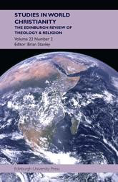
 By now, new research on the COVID crisis is making its way into journals and soon into books– just when the reading public and probably many journalists are suffering from “pandemic fatigue.” But for a comparative understanding of how churches in the global South have responded to the crisis, the current issue (26.3) of the journal Studies in World Christianity has brought together several fascinating articles on the subject. The editorial notes how the pandemic arrived during major Christian holy days and required rapid and innovative responses on the part of churches with limited resources to keep in touch with the faithful. The first article by Adam Mohr sets the tone by examining world Christianity and to the Spanish flu of 1918, with “revival” breaking out among an “anti-medicine” church movement in Africa with roots in Philadelphia. The different postures of the churches in relation to their governments are examined in many of the articles.
By now, new research on the COVID crisis is making its way into journals and soon into books– just when the reading public and probably many journalists are suffering from “pandemic fatigue.” But for a comparative understanding of how churches in the global South have responded to the crisis, the current issue (26.3) of the journal Studies in World Christianity has brought together several fascinating articles on the subject. The editorial notes how the pandemic arrived during major Christian holy days and required rapid and innovative responses on the part of churches with limited resources to keep in touch with the faithful. The first article by Adam Mohr sets the tone by examining world Christianity and to the Spanish flu of 1918, with “revival” breaking out among an “anti-medicine” church movement in Africa with roots in Philadelphia. The different postures of the churches in relation to their governments are examined in many of the articles.
The article on the churches response in Singapore shows how they were largely compliant with government health mandates, showing their good citizenship but also hindering their role as a critical voice regarding the state’s lapses in dealing with the pandemic. In the Philippines, the sacramental role of the Catholic Church and the poverty of the people and their lack of access to technology made the practice of “spiritual communion” central, as the Monstrance containing the communion elements was paraded through its communities. In Cambodia, the online observance of Christian services during lockdown led to less religious conflict between Buddhists and Christians. A concluding article looks at the way doctrinal positions were put to the test during the pandemic—from the nature of ecclesial authority and the sacraments, as well as the new dilemma of balancing in-person and online ministries when the latter draws more crowds and attention.
For more information on this issue, visit: https://www.euppublishing.com/loi/swc